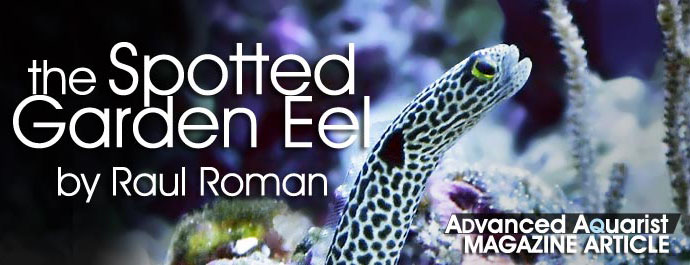
Whether you’re contemplating an upgrade or perhaps setting up a second tank, you might have at some point considered a garden eel dominated display. A favorite exhibit at many public aquariums around the world, garden eels make very interesting and visually appealing displays but they require special accommodations in order to make a successful transition to a captive environment. Unfortunately garden eels are often doomed to death because they are readily available for purchase to the saltwater aquarium hobby and become the victims of an impulse purchase that is not preceded or followed by an understanding and appreciation for providing them a suitable habitat (Hemdal 2009). I first saw these wonderful creatures at the Georgia Aquarium a few years ago and was completely enthralled with the eel’s unique behaviors. They looked like thin blades of sea grass swaying with the water’s current, that is until they completely disappeared as they retreated into their subterranean homes.
I came back home from that Georgia Aquarium visit and found myself searching for information on garden eels to see if these were suitable home aquarium inhabitants but I found very little captive care information that was home aquarium specific. I did not revisit this until years later when I had an opportunity to upgrade my reef aquarium into a 150 gallon cube-shaped glass tank. I was looking to setup a reef display that would renew my love of the marine aquarium hobby while taking advantage of the new tank’s unique dimensions (36″ wide x 36″ long x 27″ high). I decided to explore setting up a garden eel aquarium and this time my Internet searches yielded a couple of hobby specific articles exploring the feasibility of a garden eel dominated aquarium. While these two articles covered the basic information needed to get me started, I’ve learned some great lessons from having successfully housed six Spotted Garden Eels (Heteroconger hassi) in my home’s reef aquarium and it is my hope to give you the detailed information needed to setup and maintain a thriving garden eel dominated home aquarium.
The obligatory taxonomy information
Spotted Garden Eels belong to the Congridae family (conger eels) and the heterocongrine subfamily. The heterocongrine subfamily of eels all use their tails to dig burrows in the sand. In the wild they live in large colonies where they each reside in their own dug burrow. Garden eels have the ability to fully retract into their hole but they generally expose most of their body length in order to catch zooplankton that drifts by with the current (Smith 1989). Spotted Garden Eels are a tropical fish found mainly in the Pacific, Indian and Red shallow seas (Shedd Aquarium 2011). My experience and expertise is solely with the Spotted Garden Eel but this also happens to be the species most often offered to the aquarium hobby. A very similar species commonly named the Splendid Garden Eel (Gorgasia preclara) is less frequently available to the hobby but shares many of the husbandry needs of the Spotted Garden Eel and are sometimes even housed together in the same exhibit at some public aquariums (Randal & Allen & Steene 1997).
I should note that it is not my intention to write a scientific journal article about the taxonomy of the Spotted Garden Eel and thus I’ve only shared with you the basics on that subject. I think it is vitally important to at least have a basic understanding of the classification of any species you intend to keep as this aids in avoiding the confusion sometimes encountered when specimens are only known and referred to by their common names, which unfortunately are often shared by other species. This will conclude the science lesson and I shall proceed to what you really want to know, how to setup a successful Spotted Garden Eel aquarium in your home.
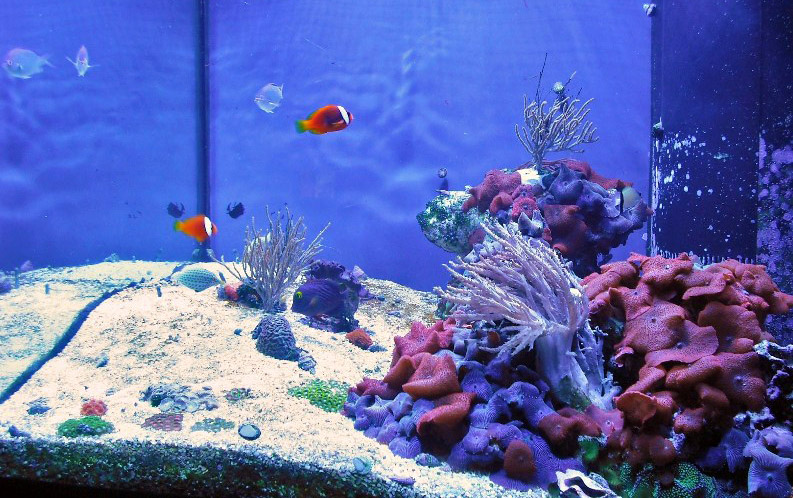
Shot of author’s garden eel aquarium showing large open sandy area dedicated to the six Spotted Garden Eels residing in the display.
Tank and Stocking Recommendations
The discussion of keeping garden eels in an aquarium should start with the minimum and ideal dimensions of the aquarium housing the specimens. Because of their colonial nature, you will want to accommodate a minimum of 3 eels in your setup. This can be accomplished in a tank as small as a standard glass aquarium with a width, depth and height of at least 18 inches. This is only possible provided that the eels are the only specimens in the tank. This small setup would present some unique challenges and I would only recommend it to an experienced hobbyist.
If you are looking to do this on a grander scale then I would recommend 6 to 10 eels as an ideal setup for a home aquarium. If this is your goal then you will want to plan for 1 square foot of open sandy substrate per garden eel pair. Be sure to factor in any areas of the tank’s bottom surface which you plan to cover with corals or rocks as these will have to be subtracted from the available eel space. The space allocated to the eels will need to be contiguous so that they can mimic their colonial housing inclinations. The bottom line is that any aquarium housing Spotted Garden Eels will need a large open sandy area and this will likely be inconsistent with our usual inclinations to fill most of the aquarium’s space with rocks and corals with very little real state devoted to the open sand areas. The ideal tank will have a height equal to or greater than 24 inches and a depth (front to back) of at least 24 inches. A standard 120 gallon or 180 gallon glass aquarium is in my opinion ideal for a garden eel setup. These tanks will give you the needed room to incorporate some live rock and corals into the display making for a more aesthetically pleasing setup. Cube tanks with at least 4 square feet of surface area (24 in x 24 in) and 24 inches of height are also a good place to start if you are looking to go with a cube-shaped tank. Keep in mind that the bigger the tank the more space you can devote to live rock and corals.
As an example my 150 gallon cube aquarium has 9 square feet of surface area with a 27 inch height. I have chosen to devote about 3 square feet of that space to be covered up with live rock and it resides towards the rear of the tank. This left me 6 square feet of surface area to devote to the eels. Following my stocking recommendations I could have housed up to 12 garden eels in this area but I choose to go with 8 eels for my initial purchase. I lost 2 of the eels to shipping stress and this is something you will want to factor into the stocking equation as my supplier confirmed to me that Spotted Garden Eels don’t always ship well. In fact some online vendors even exclude them from their live arrival guarantee because of their poor track record. Even when provided with an ideal habitat as in a public aquarium exhibit, 75% + mortality rates were cited by Jay Hemdal in a recent Advanced Aquarist article (Hemdal 2009). According to Hemdal these high mortality rates can be attributed to poor handling during collection and shipping.
A burrow-friendly substrate
The need for a substrate of a minimum depth is probably the most readily available information you can find on keeping garden eels in an aquarium. This is indeed a very important topic and I want to go into some detail on what I’ve found to be most effective. There seems to be a consensus that an 8 inch deep substrate is the minimum that should be provided as a home for your garden eels. This depth is mostly derived from these 2 facts: the Spotted Garden Eel can reach a length of 16 inches and they generally keep ½ of their body inside the burrow (Shedd Aquarium 2011). Generally, Spotted Garden Eels are offered in lengths well short of their 16 inch maximum length and their captive length is likely to not exceed 11 inches since the maximum length usually given is reflective of the largest specimen encountered, not the average length and work by Jay Hemdal has estimated that 2/3 of the maximum size is a more accurate predictor of maximum captive size (Hemdal 2009b). Since the Spotted Garden Eel can and does retract completely inside their burrow either when seeking protection or during the tank’s dark period you might think that a 12 inch substrate depth might be a more ideal depth and if you have a tank tall enough to accommodate a 12 inch deep substrate then I would recommend that as an ideal depth. I will note that absent of a substrate depth equal to the eels length, the eel will still retract completely inside their burrow by extending their burrow parallel to the tank’s glass bottom.
If your goal is to have an attractive aquarium setup then having 8 to 12 inches of substrate, which is visible as a cross section on the front of the aquarium glass, may not be all that appealing to you. There are several ways to aid with this problem. Choosing a tank with a height of greater than 24 inches will allow you to accommodate the greater substrate depths while keeping a proportionally attractive substrate to water column ratio. My tank’s 27 inch height was ideal for allowing me to support my choice of an 8 inch deep substrate while still maintaining a 19 inch tall water column that is fish friendly and visually appealing. I was also able to avoid the wall of sand up against the front to the glass by laying down a slopped substrate which slopped to a more pleasing depth of 2 inches against the front glass panel. Creating this slope can be a tricky endeavor that is made easier by using coral rubble and course crushed coral in the substrate mix to help prevent gradual erosion and leveling of the slope. The deeper (front to back) your tank is the easier it will be to create a visually appealing and stable sloping substrate.
In addition to the practical use of coral rubble and crushed coral for a substrate, I recommend using a fine reef-grade sand to make up the bulk of your eel area’s substrate as this will facilitate the sort of burrowing that the Spotted Garden Eel performs. Note that a fine substrate burrow will be reinforced and protected from collapsing by being coated with a secretion that the garden eel uses for just that purpose (Shedd Aquarium 2011). One other important recommendation is to use a courser sand to comprise the top ½ inch of the substrate. This will keep the sand from being blown around by the current you will need to generate across the sand bed in order to mimic the natural feeding behavior of the garden eel.
Garden Eel’s compatible neighbors
The Spotted Garden Eel is unique from other eels (morays, snowflakes, etc.) in that it is 100% reef safe. A garden eel’s diet is comprised of floating zooplankton brought to it by the water’s current. The garden eel will always keep a part of its body inside the burrow even when feeding. If it cannot reach the food while also maintaining a “foot” in its burrow it will just simply let it pass by uneaten. For this reason the spotted garden eel is even compatible with the smallest of ornamental shrimps and you simply won’t have to worry about the eel eating its neighbors. You will however have to worry about the eel’s neighbors eating the eels due to their small size and docile nature. In the wild triggerfish are known for digging out garden eels right out of their burrow in pursuit of a meal (Shedd Aquarium 2011). For this reason I would avoid any aggressive fish-eating specimens as tank mates for your garden eels. A fish does not however need to have the potential to eat a garden eel to be an inappropriate tank mate. Big active fishes will spook the eels and force them to spend much of their time inside their burrows or with only their heads sticking out. This will prevent them from eating properly and cause them undue stress. A bigger tank will mitigate some of these problems with bigger active fishes. Even when initially bothered and scared by fish swimming in close proximity, the eels will eventually adjust to their presence and cease to retreat when a fish darts close to its burrow.
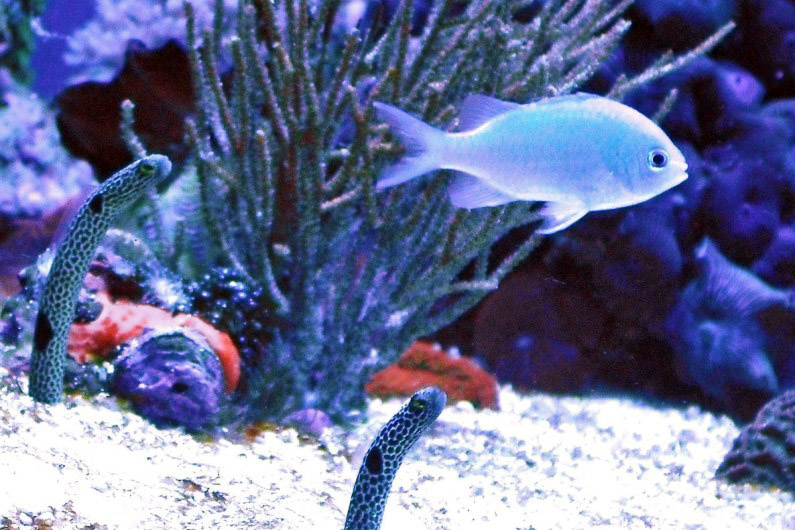
Despite being very active fishes, the Spotted Garden Eels quickly became used to the Blue Green Chromis in the author’s 150 gallon cube aquarium.
Because of their propensity to being startled, one might (if circumstances allow), place only the eels in the tank initially to give them an opportunity to acclimate and begin to feed properly. Follow a slower than normal acclimation of the eels prior to introducing them to the tank and properly guard your overflows when you release them as they can end up in your sump when first introduced into the tank as they are a bit disoriented and exploring their new habitat looking for a suitable home. You should not worry if the eel’s first make a home in a shallower area of the tank as long as it isn’t so shallow that it causes damage to the eel’s tail. Most likely their initial burrow will not be their permanent home and they will probably move around a good bit for the first few weeks until they find their preferred spot. Try not to panic if your garden eels disappear for several days following their introduction as they have likely buried themselves in the sand and are just too scared to emerge from the safety of their burrow.
In addition to some fish mates you may wish to adorn your garden eel aquarium with some live rock and corals. This is usually not a problem but here are some things you might want to take into consideration. As you will see in the next section garden eels need to be fed often and this will likely make the keeping of some coral species, ones that require perfectly pristine water, nearly impossible. Make sure to create a stable live rock structure that won’t be undermined by an eel that decides to dig its burrow near one of the base rocks. Other sand burrowing creatures such as pistol shrimps and sand gobies should be avoided as they will compete with your eels for real estate. I have found other sand dwelling creatures to be quite beneficial and I would recommend a small army of nassarius, and cerith snails to help in maintaining the top layer of your sand bed. In addition to these snails, some of the smaller reef-safe hermit crabs can also be employed. Sand-dwelling spaghetti worms, sea cucumbers and medusa worms can also help to keep the sandy areas free of uneaten food and fish waste.
A very unique eater (Flow and Nutrition)
As mentioned earlier, the feeding range for a garden eel is restricted to mere inches from its burrow. This presents a unique challenge for the hobbyist looking to provide adequate substance for their Spotted Garden Eels. I have been most successful in creating a gyre-style flow pattern within my tank that steadily runs a gentle current across the surface of the sand. In my particular setup the current climbs up the substrate’s slope and across the entire surface of the area occupied by the eels. Note again that the eels will initially move a few times until they find their preferred location and you’ll soon discover that this has everything to do with the current and the food in the current. To feed my eels I simply put the food in the path of the pump creating the flow. The food is quickly delivered to where the eels have made their home and as an added advantage of the gyre flow pattern any food missed during the food’s first pass will soon make its way back around and this gets repeated several times giving the eels ample opportunities to grab their share of passing morsels. My suggestion would be to play with your circulation pumps to achieve a gentle and properly directed flow and remember that the eels will fine-tune their location so you won’t have to fine-tune the flow.
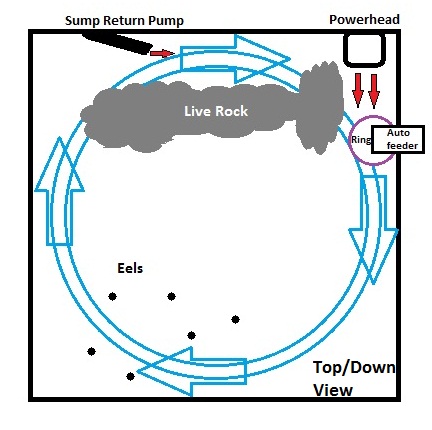
Flow diagram of gyre style flow as implemented in author’s 150 gallon cube aquarium. Flow is generated with a propeller type powerhead and the return tube from the sump’s pump. Also depicted is the Auto-feeder and feeding ring which inject food directly into the flow and into the path of the hungry eels.
Now that we’ve covered the delivery method let’s delve into what the Spotted Garden Eel should be fed. In the wild, stomach content has shown that they mostly consume copepods, fish eggs, prawn eggs and other small zooplankton (Shedd Aquarium 2011). Initially you will want to feed your eels something that most closely resembles their wild diet. Once acclimated however, I have found captive garden eels to be voracious and indiscriminate eaters. I have experimented with many food types for my eels and I found the following frozen diets, which are readily available at hobby retailers, to be most appreciated: prawn eggs, fish eggs, oyster eggs and red cyclops. If initially unsuccessful with these diets, I can almost guarantee acceptance of small enhanced live brine shrimp. These should neither be newly hatched nor adults but someplace in-between. I accomplished this by hatching some brine shrimp eggs and harvesting them when they reach the appropriate size. Be sure to gut load the brine shrimp prior to feeding them to your eels for maximum nutrition. Once these are accepted, start to mix in the frozen diet with the live brine shrimp and it won’t be long before you can discontinue the live food except as an occasional treat.
To my surprise, established and healthy Spotted Garden Eels will soon take to flake food, pellets and even tackle larger morsels of frozen fish diets. My eels will basically eat anything passing by that they can accommodate into their mouths. In a tank featuring corals, invertebrates and fish this will allow you the convenience of communal feedings with community targeted diets rather than having to spot feed your eels separately from the other tank inhabitants. In my aquarium I accomplish this with one daily feeding of a commercially prepared frozen marine blend, which features a mix of food in all sizes from coral polyp-sized items to bigger chunks for your bigger fishes. There are several manufacturers that feature such frozen concoctions so try a few until you find the one that works best for you. I supplement my one daily frozen food feeding with 4 additional daily feedings of my own dry food mixture which is evenly portioned and timed by an automatic feeder. The mixture is composed of a variety of high quality flakes, pellets and freeze dried diets by various different aquarium food manufacturers. I consider these five daily feedings necessary if one is to succeed in keeping Spotted Garden Eels. Remember that these eels are locked into their positions and do not forage throughout the aquarium for food. The food must be present in the water column and it must come to them or they will starve. Spotted Garden Eels can be observed from dawn to dusk constantly sifting the water near them for passing food; they will not survive long with one or two feedings a day. Multiple daily feedings are very easily accomplished with the use of an automatic feeder and I will further recommend that the feeder drop its food into a feeding ring directly above the flow of one of your circulation pumps. The ring will allow the food to gradually saturate with the tank’s water at which point it will sink below the ring and get carried away by the pump’s current to be delivered to the anxiously awaiting eels.
Quantity is also very important as these creatures are able to consume as much as 600 pieces of zooplankton during one meal (Shedd Aquarium 2011). As mentioned earlier, we are talking about zooplankton the size of copepods so this might not be as much as you might imagine but nonetheless it is a good guide for determining the amount of food they should consume. As a reference, my six eels are fed a 1 inch by 1 inch chunk of the frozen blend that is about ¼ of an inch thick. The 4 auto-feeder meals are each around ½ a teaspoon in volume. This feeds my entire tank of about 13 small fishes in addition to the six garden eels so you might assume that about ½ of that food is actually consumed by the garden eels. By now I know what experienced hobbyist are probably thinking, “Is he nuts! You can’t feed that much and not encounter water quality and algae problems.” And the truth is that you are partially correct but I will talk about how I deal with that in the next section.
Appropriate filtration when you feed your eels a ton of food
The amount and frequency of food involved in properly feeding your garden eels will tax your average reef filtration system so a discussion on appropriate filtration is warranted. I have found that it is beneficial to employ 4 different filtration methods in addition to regular 25% water changes and I will elaborate on each of those below.
- Mechanical filtration – A felt filter sock that captures all water exiting the overflows is very beneficial in capturing any uneaten food but it must be replaced with a clean one on a weekly basis or you end up doing more harm than good since the captured matter will begin to decompose releasing dissolved organics into the water. More frequent changes are even more ideal to prevent this from happening. In a sump-less system employing an external power filter with some felt-like material will achieve similar results.
- Biological filtration – In addition to the biological filtration taking place in your substrate and live rock, you will greatly benefit in keeping organic nutrients (phosphates and nitrates in particular) under control by employing any of the popular probiotic filtration methods. These relatively new filtration methods use carbon dosing and other supplementation to manipulate beneficial bacteria levels to more effectively process excess nutrients dissolved in that aquarium’s water (Camp 2010). I have found bio-pellets (sometime referred to as solid carbon dosing) tumbling inside an upflow media reactor to be most effective and relatively easy to implement. Use the amount of bio-pellet media recommended by the manufacturer for a heavily stocked aquarium, regardless of your bio-load. In addition to the bio-pellet reactor, I supplement the whole biological filtration process with the regular additions of live bacteria products. I’ve experienced considerable improvements in the efficiency of my tank’s biological filtration since implementing the regular addition of live bacteria so don’t overlook this important step. There are several reputable companies that offer live bacteria products and I would suggest getting their recommendations as well as those of actual users of the products.
- Chemical Filtration – An upflow media reactor running activated carbon and granular ferric oxide is also employed in my setup to help to further filter the water from pollutants and dissolved organic compounds.
- Protein skimming filtration – this is sometimes listed as another form of mechanical filtration but it does so much more than traditional mechanical filtration that I think it warrants its own category. An appropriately sized protein skimmer is a must have in a garden eel system and I have found protein skimmers employing a cone or a hybrid cone-shaped body to be very efficient. A bubble diffuser employed in the skimmer design is another feature I would look for in a good protein skimmer. Skimmer technology is something that quickly changes and I would suggest that you do your homework and seek advice from knowledgeable hobbyist when choosing your protein skimmer. I will also recommend that you place the output of your bio-pellet reactor as close to the intake of your protein skimmer as possible. This is how you will export the excess bacterial bio-mass as well as their waste by-products.
While I find this to be a good working model for limiting dissolved organics and consequently reducing nuisance algal growth, there are various combinations of this particular setup as well as other methods (frequent and substantial water changes for example) which you might find equally effective. This is just one setup which has worked extremely well for me.
Normal captive behavior
I think it is always helpful to know what to expect from a new and unfamiliar aquarium acquisition. I regularly see post on online forums where some hobbyist is asking if what their fish is doing is normal. Garden eels do not behave like most other eels in the hobby so you might think something is wrong with your garden eels when in reality it is normal behavior. The following behaviors and situations were encountered by me during the course of setting up and maintaining my Spotted Garden Eel aquarium.
- Once acclimated and usually by the first month of captivity, you will not see your eels moving their burrows around. They will stay put except to move up on a mate or to escape aggression from conspecifics.
- Spotted Garden Eels will completely retreat inside their burrow when the lights go out at night and will not emerge until the lights come back on in the morning.
- It might take several months before you begin to see your eels regularly exposing most of their body during feedings. Prior to that it is not uncommon to have them just sticking out a mere one or two inches.
- Garden eels will fight as a course of mate competition and when in too close proximity to one another. They won’t fight to the death but this usually keeps the more submissive eel at a disadvantage in gathering food.
- Once fully acclimated (1 month or so) a healthy Spotted Garden Eel will remain with part of their body exposed for most of they day and particularly when being fed.
- Garden eels will not try to escape their confines like other eels do. The one exception to his would be immediately after being introduced to their new tank. Keeping a watchful eye during the first hour or so is all that is needed. An open top tank or one with a screen top is perfectly acceptable.
- Garden eels will coward to just about anything that gets too close, this includes the aquarist so try not to get too close to the glass until they get used to your presence.
- Garden eels will expose their body the most when eliminating waste. They will do this several times per day and particularly following a meal. Their anus is located about ¾ of the way down in the front part of their body and is easily identified because it resides inside one of their large black spots.
Learn and share
I hope you will not look at this article as a cookie cutter method for setting up a successful Spotted Garden Eel aquarium as that is not my intention. This article will however arm you with some detailed information which you can try to implement in your own setup. None of the items recommended in this article need be of a certain expense. Shopping around, buying used, building your own and doing your homework will aid in coming up with affordable yet effective methods of housing and maintaining your Spotted Garden Eel aquarium. I will also suggest that you reach out to other hobbyist on online forums and local reef clubs as their experience could prove to be an invaluable resource not only in setting up the aquarium but in helping you solve any unforeseen problems. Most importantly, take the time to share your experiences and learned lessons with others so that we can all benefit and succeed in keeping this beautiful and intriguing creature.
Links to YouTube videos
http://www.youtube.com/watch?v=QtxHiTnh3Qw
Video of Spotted Garden Eels at feeding time in author’s aquarium.
http://www.youtube.com/watch?v=stEDhMGSfhU
Video depicting curious elimination behavior of Spotted Garden Eel as captured by author.
About the Author: Raul Roman holds a Bachelor of Science degree and has over 20 years experience in the saltwater aquarium hobby. This experience ranges from hobbyist to owner and operator of a coral propagation business. Raul’s current involvement in the hobby is as the president of the Marion Ocala Reef Enthusiasts and the caretaker of his 150 gallon garden eel dominated reef aquarium. Raul can be reached at [email protected] for comments or questions.
References
- Camp, M. 2010. (2010, September 16). Probiotics Demystified. Coral Magazine, pp. 58-74.
- Hemdal, J. (2009, December). Aquarium Fish: Mortality Rates of Fishes in Captivity. Advanced Aquarist. pp. 20-21.
- Hemdal, J. (2009b, February 22). Maximum Sizes of Fishes in Captivity – an estimation tool. Retrieved July 10, 2011, from http://www.reefs.org/forums/topic127751.html
- Smith DG. 1989. Family Congridae. In: Bo¨hlke EB, editor. Fishes of the Western North Atlantic. New Haven: Sears Foundation for Marine Research. pp 460-567
- Randall, J. E. and Allen, G.R. and Steene Randall, J. E. and Allen, G.R. and Steene, R.C. 1997. Fishes of the Great Barrier Reef and Coral Sea. Crawford House Publishing. 494p. ISBN# 9781863331401.
- Shedd Aquarium. Explorer’s Guide: Spotted Garden Eel. Retrieved May 17, 2011, from http://sea.sheddaquarium.org/sea/fact_sheets.asp?id=108


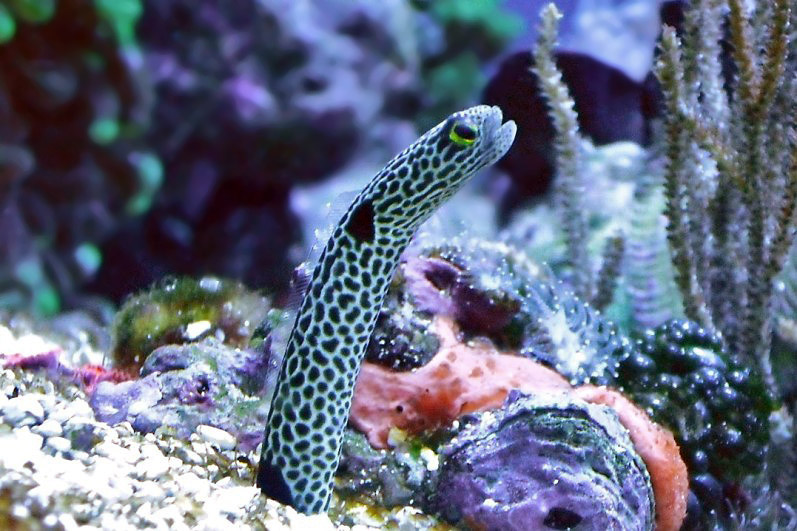

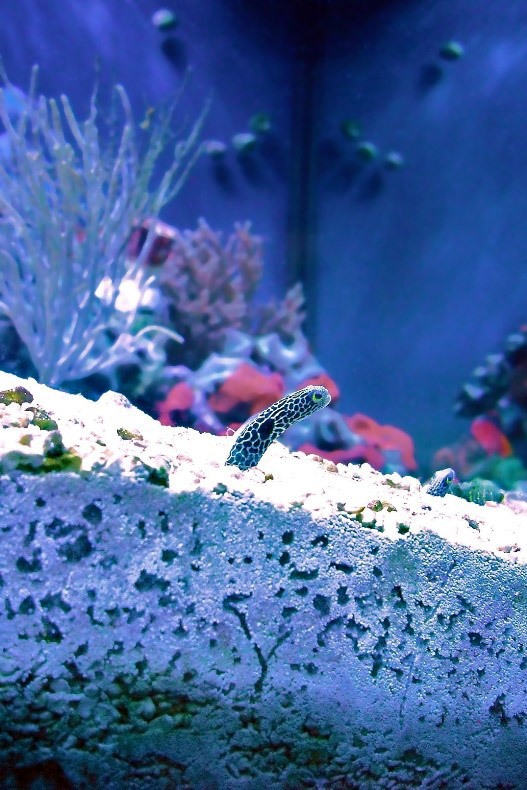

Thank you for this article, we just got a garden eel the other day and had not seen it for 2 days, i was starting to panic when i read your article, later in thre day he came out and ate. we also noticed that he has made a borrow horizontally so we will have to add more depth to his sand.
thank you